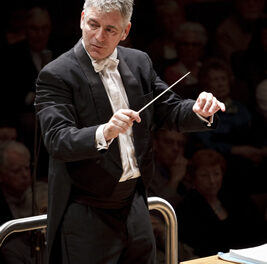The East Carolina University Symphony Orchestra opened its 2014-15 season with an orchestral showpiece and a most unusual concerto – one written for the tuba.
The tuba concerto featured Tom McCaslin, professor of tuba and euphonium in the School of Music, and contained some typically booming low notes, along with some of the highest notes one could imagine coming from the instrument, a few lower-than-low notes and even some odd blurts, burps, and other odd sounds here and there. The music, by Jorge Salgueiro is called “cONCERTO for tUBA and oRCHESTRA,” Op. 139, and the playfulness of the title indicates some definite playfulness in the composition, as do the titles of the movements (played without pause): “dEPTHS,” “bEATING,” “cADENZA,” “fANTASY” and ‘fIREWORKS.” Musically, the chords and harmonies and even melodic lines are quite accessible to the audience, and it was interesting to hear McCaslin’s tuba as a prominent solo instrument. Other concertos have been written for the tuba (Ralph Vaughan Williams’ being perhaps the most prominent), but it is not likely that many in the audience ever had heard this particular composition.
The concerto begins with a faint, ghostly cushion of strings and celesta, and the tuba enters at just about the lowest register imaginable – and then gets even lower. Starting from a sense of menace or foreboding, the piece builds in intensity in both the orchestration and solo line. During the course of the piece, McCaslin played several phrases employing different playing techniques. The ending of some phrases sound almost like musical hiccups, with some of the tuba’s line played against a backdrop of what could have been kazoos – !! – but likely were just the brass players humming through their mouthpieces. Other phrases resemble the sound of whale songs, while parts of a cadenza recall the musical theme of the meeting in Wyoming of the mother ship and the scientists and technicians in Close Encounters of the Third Kind. At other times, however, McCaslin’s tuba offered a warm and mellow – and melodic – sound. After a splashy symphonic passage, the concerto ends all-too-abruptly. McCaslin handled all the different demands of the piece expertly, and the orchestra provided good accompaniment.
The orchestral showpiece on the program was Mussorgsky’s Pictures at an Exhibition, and the players acquitted themselves quite well in this grand, large-scale work. Despite a few slips in some exposed solo passages and a few less noticeable musical missteps in some ensemble passages, the orchestra handled both the high-powered and the subtler sections well. And after hearing this piece live, one can not only admire the players for their performance but also Maurice Ravel’s excellent orchestration of what started out as a solo piano composition and how he turned it into such an enjoyably explosive piece.
Under the direction of conductor Jorge Richter, the ECU orchestra showed strengths in strings, brass, and winds, supported by precise and well-timed percussion. The famous finale, “The Great Gate of Kiev,” surely one of the most thrilling of all orchestral climaxes, was perhaps the highlight of the performance, with especially well-played brass and percussion, but there were other strong sections too, such as the effervescent “Tuileries” and lively “Ballet of the Unhatched Chicks.” Richter maintained a fairly crisp tempo for the entire piece, and except for a few instances at the beginning (the quickly descending bridges in the lower strings) the players kept up with his pace.
The concert opened with the march and scherzo from Prokofiev’s The Love of the Three Oranges led by master’s degree student Laura Morgan, who also is a violist in the orchestra. She showed an energetic hand, perhaps a bit stiffer than need be, although the music demanded a high degree of precision, with emphatic entrances and cutoffs, and not much room for grand or flowing gestures on the part of the director or highly emotional reading by the musicians. The players seemed a tiny bit behind her direction at the outset but improved their alignment as the two sections proceeded. There were a few missed notes in the march, but the scherzo seemed to be played spot on.
This Wright Auditorium performance was a good concert to open the new season. Richter seems to have a skilled group of players, from freshmen to graduate students, and one would expect to hear fine music from this ensemble throughout the year. The next program – with choruses – will be offered on Saturday, October 18, at St. Paul’s Episcopal Church. For details, click here.











